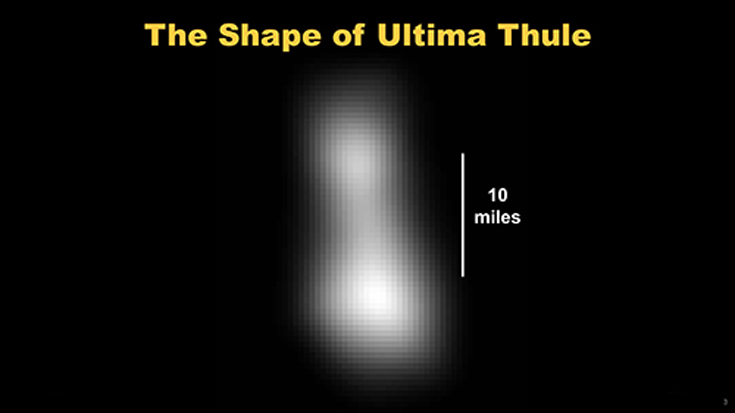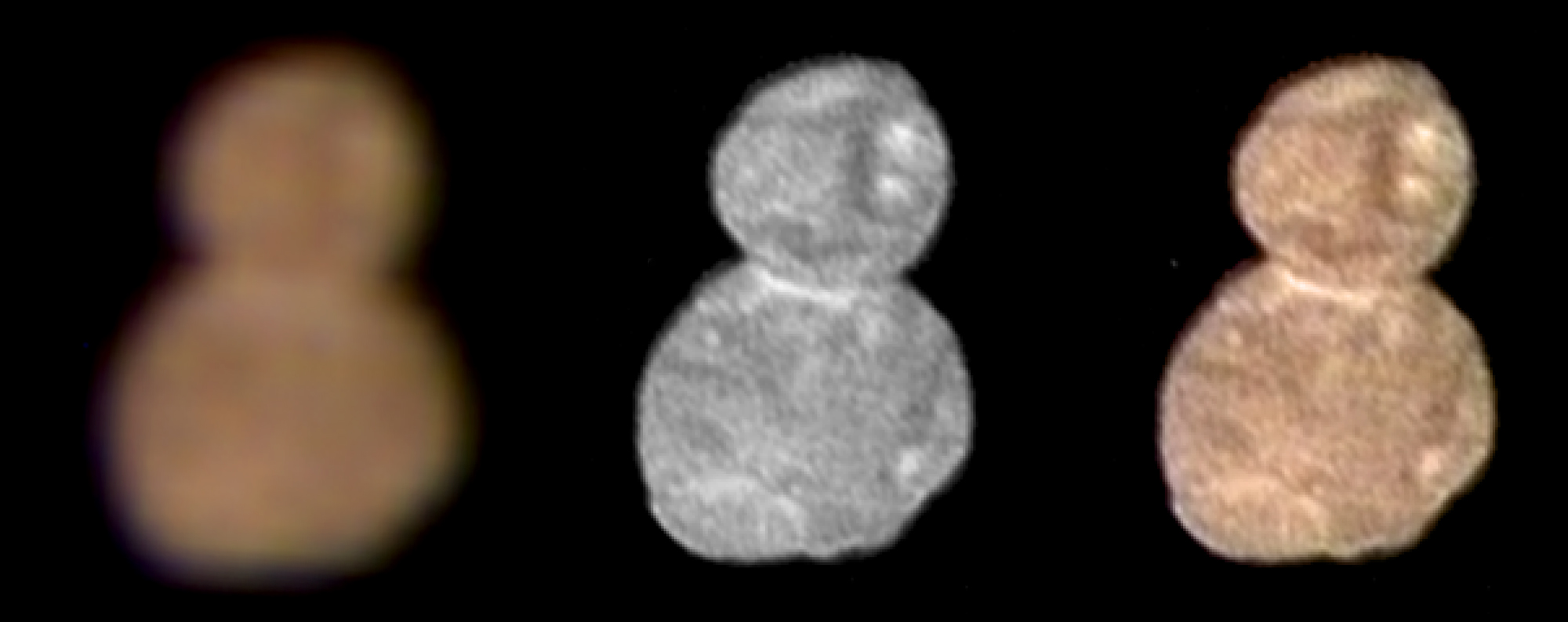2014 MU69: Arrokoth, the most distant object ever explored
On Jan. 1, 2019, New Horizons made a flyby of the most distant solar system object ever explored, the Kuiper Belt object 2014 MU69, also known as Arrokoth..
After its famous flyby of Pluto in July 2015, NASA's New Horizons spacecraft made history a second time when it buzzed the most distant object ever explored: 2014 MU69.
"We set a record! Never before has a spacecraft explored something so far away," Alan Stern, the New Horizons principal investigator, said after the flyby. "I mean, think of it. We're a billion miles further than Pluto, and now we're going to keep going into the Kuiper Belt."
Both Pluto and 2014 MU69 lie within the Kuiper Belt, a collection of icy rocks that surrounds the outer reaches of the solar system. These objects are thought to be pristine samples from the early solar system, cast out into the boundary zone through gravitational interactions with the larger objects that would grow into planets. Examining them should reveal insight into what was happening in the solar system in the first stages of its lifetime.
Previously known by its nickname Ultima Thule (pronounced TOOL-ie), MU69, now officially named Arrokoth, was the first object in space to be explored by a spacecraft that launched before the object's discovery.
Beyond Pluto
As early as 2003, the National Academy of Sciences' Planetary Decadal Survey strongly recommended that the visit to Pluto include flybys of small Kuiper Belt objects (KBOs). Observing multiple targets would provide greater insight into the previously unexplored segment of the solar system. New Horizons launched in 2006 with extra fuel for such a flyby, and its power and communications systems are prepared to work at distances beyond Pluto's orbit for years to come.
In 2011, mission scientists used ground-based telescopes to begin searching for a second target, but none of the new discoveries were within the reach of New Horizons. In 2014, the Hubble Space Telescope joined the search, locating five potential objects. One of them was 2014 MU69, which was labeled 1110113Y after its June 26, 2014, discovery and also called PT1 ("potential target 1") after its elevation to one of two possible destinations. In August 2015, the New Horizons team selected 2014 MU69 as its next potential target.
"2014 MU69 is a great choice because it is just the kind of ancient KBO, formed where it orbits now, that the Decadal Survey desired us to fly by," Stern said in a statement. "Moreover, this KBO costs less fuel to reach [than other candidate targets], leaving more fuel for the flyby, for ancillary science, and greater fuel reserves to protect against the unforeseen."
MU69 lies about 1 billion miles (1.6 billion kilometers) beyond Pluto.
Naming 2014 MU69
In 2017, the New Horizons team requested suggestions from the public for a nickname for the KBO as part of an outreach campaign. The final decision, Ultima Thule, is a term used in medieval times that means "beyond the known world." The nickname was submitted by about 40 different people, NASA officials said.
"MU69 is humanity's next Ultima Thule," Stern said when the name was announced.
The nickname spurred controversy because of its historical use by Nazi forerunners and modern use by extremist groups. However, the New Horizons team decided to stick with the nickname despite the potentially negative connection.
"I've said it a number of times, I think New Horizons is an example — one of the best examples in our time — of raw exploration, and the term Ultima Thule, which is very old, many centuries old, possibly over a thousand years old, is a wonderful meme for exploration," Stern said after the flyby. "That's why we chose it. I would say that just because some bad guys once liked that term, we're not going to let them hijack it."
However, in November 2019, mission team members announced that the official name of 2014 MU69 would be Arrokoth, a word that means "sky" in the Powhatan/Algonquian language.
"The name 'Arrokoth' reflects the inspiration of looking to the skies and wondering about the stars and worlds beyond our own," Stern said in a statement. "That desire to learn is at the heart of the New Horizons mission, and we're honored to join with the Powhatan community and people of Maryland in this celebration of discovery."

Before the flyby
Astronomers used the help of three different stars to study Arrokoth before its arrival. When an object like a KBO travels between Earth and a star, astronomers can use the starlight to study the distant target, a technique called stellar occultation. Arrokoth traveled between Earth and several different stars — one each day — on June 3, July 10 and July 17, 2017. Each event lasted only 2 seconds or so and was only visible from a narrow band of land and sea on Earth.
"This effort — spanning six months, three spacecraft, 24 portable ground-based telescopes and NASA's SOFIA airborne observatory — was the most challenging stellar occultation in the history of astronomy, but we did it!" Stern said. "We spied the shape and size of 2014 MU69 for the first time, a Kuiper Belt scientific treasure we will explore just over 17 months from now. Thanks to this success, we can now plan the upcoming flyby with much more confidence."
Measurements from all three of the 2017 observations revealed that Arrokoth wasn't orbiting where it was expected. And, a small blip during the July 10 observation puzzled astronomers because it looked like MU69 was actually two separate objects. Together, the results suggested that MU69 wasn't spinning through space alone. Astronomers thought that MU69 may have at least one moon, and could host even more natural satellites.
"This might be the harbinger," Stern said during a news conference at the 2017 American Geophysical Union (AGU) Meeting. "It might hint that there is actually a swarm of satellites from MU69."
The New Horizons team got one final glimpse of Arrokoth before the New Horizons flyby. On Aug. 4, 2018, a final occultation was visible from Earth, seen only in Senegal and Colombia
"This occultation will give us hints about what to expect at Ultima Thule and help us refine our flyby plans," Marc Buie, the New Horizons occultation-event leader, said in a statement.
A New Year's Eve to remember
On Jan. 1, 2019, at 12:33 a.m. EST, New Horizons made its historic flyby of MU69. Team scientists and engineers gathered at the Johns Hopkins Applied Physics Laboratory in Laurel, Maryland, to ring in the New Year and cheer for the moment the spacecraft buzzed the KBO. Brian May, a mission scientist and lead guitarist for the band Queen, released a new single commemorating the event. But Ultima Thule is so far away that no one knew for sure whether or not the mission had completed a successful flyby until almost 10 hours had passed.
During the flyby, New Horizons passed Ultima Thule at a distance of about 2,000 miles (3,540 km), which was 5,800 miles (9,300 km) closer than it flew by Pluto.
After the flyby, NASA released the first resolved photos of Ultima Thule, revealing that the 21-mile-long (33 kilometers) object is composed of two roughly spherical lobes. The pair are joined tightly at the neck, where material shines more brightly than along the rest of the object.
"It's a snowman, if it's anything at all," Stern said when the first color image was released.
The team decided to call the largest lobe "Ultima" and the smallest "Thule." Both lobes appear red, likely due to discoloration from deep-space radiation, researchers said. The pair most likely started out as two separate objects that gradually came together, moving less than a mile per hour.
"If you collided with another car at those speeds, you may not even bother to fill out the insurance forms," Jeff Moore, New Horizons co-investigator from NASA's Ames Research Center in California, said during the flyby.
Ultima Thule is one of a large population of objects that fill the Kuiper Belt. Eventually, similar material combined to build up moons and planets. New Horizons' images of the KBO will help provide insight into how those pieces came together to shape the solar system.
"We think what we're looking at it is perhaps the most primitive object that has yet been seen by any spacecraft, and may represent a class of objects which are the oldest and most primitive objects that can be seen anywhere in the present solar system," Moore said.

Far out
Before New Horizons reached its second target, details of Ultima Thule were difficult to make out, even through the lens of the Hubble Space Telescope. The tiny object is less than 1 percent the size of Pluto, which was why New Horizons' close-up look was so important.
"There's so much that we can learn from close-up spacecraft observations that we'll never learn from Earth, as the Pluto flyby demonstrated so spectacularly," New Horizons science team member John Spencer, said in a statement.
"The detailed images and other data that New Horizons could obtain from a KBO flyby will revolutionize our understanding of the Kuiper Belt and KBOs."
New Horizons snapped its first image of Ultima Thule in August 2018, on the first attempt, while still more than 100 million miles (170 million km) away. At the time, the target remained one of several dots among a field of stars.
Even as the spacecraft closed in on Ultima Thule, the object remained difficult to decipher but an unusual signal hinted at its bilobed shape and rotation angle. Even in the hours before the historic event, Ultima Thule refused to yield many of its secrets. The KBO remained unresolved, barely filling two pixels worth of images. As for its then-puzzling shape, Spencer could only say, "We know it's not round."
Only after the flyby were some of the mysteries finally resolved. It turned out that the KBO rotated much like the hands of a clock facing the spacecraft, a mystery that was only resolved just before the flyby. The close encounter revealed a roughly 15-hour rotation period.
New Horizons will take 20 months to send its data back to Earth. Scientists will pore over that data for years to come to learn as much as possible about the Kuiper Belt.
And it's likely that New Horizons won't stop retrieving information about the Kuiper Belt for quite a while. The spacecraft should have enough fuel to visit another KBO. According to Stern, New Horizons will be in the Kuiper Built until 2027 or 2028.
"It would be silly not to look for another target," Stern said.
Additional resources:
- NASA's 2014 MU69 web page
- NASA's New Horizons mission page
- Principle Investigator Alan Stern's mission blog
This article was updated on Sept. 22, 2020 by Space.com Reference Editor Kimberly Hickok.
Join our Space Forums to keep talking space on the latest missions, night sky and more! And if you have a news tip, correction or comment, let us know at: community@space.com.
Get the Space.com Newsletter
Breaking space news, the latest updates on rocket launches, skywatching events and more!

Nola Taylor Tillman is a contributing writer for Space.com. She loves all things space and astronomy-related, and enjoys the opportunity to learn more. She has a Bachelor’s degree in English and Astrophysics from Agnes Scott college and served as an intern at Sky & Telescope magazine. In her free time, she homeschools her four children. Follow her on Twitter at @NolaTRedd










